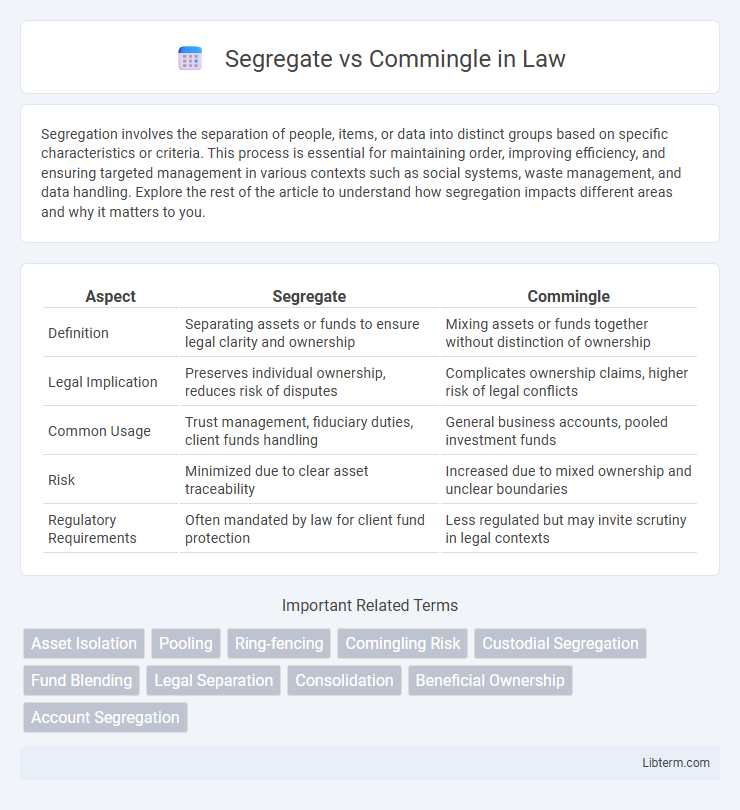Segregation involves the separation of people, items, or data into distinct groups based on specific characteristics or criteria. This process is essential for maintaining order, improving efficiency, and ensuring targeted management in various contexts such as social systems, waste management, and data handling. Explore the rest of the article to understand how segregation impacts different areas and why it matters to you.
Table of Comparison
| Aspect | Segregate | Commingle |
|---|---|---|
| Definition | Separating assets or funds to ensure legal clarity and ownership | Mixing assets or funds together without distinction of ownership |
| Legal Implication | Preserves individual ownership, reduces risk of disputes | Complicates ownership claims, higher risk of legal conflicts |
| Common Usage | Trust management, fiduciary duties, client funds handling | General business accounts, pooled investment funds |
| Risk | Minimized due to clear asset traceability | Increased due to mixed ownership and unclear boundaries |
| Regulatory Requirements | Often mandated by law for client fund protection | Less regulated but may invite scrutiny in legal contexts |
Introduction: Understanding Segregate vs Commingle
Segregate and commingle refer to distinct methods of handling assets, data, or materials, crucial in finance, waste management, and data processing. Segregation ensures clear separation for accuracy, compliance, and risk reduction, while commingling involves combining resources, often to optimize efficiency or simplify management. Understanding these concepts aids in making informed decisions about resource handling and regulatory adherence.
Definitions: What Does Segregate Mean?
Segregate means to separate or set apart distinct items, groups, or materials based on specific criteria such as type, category, or purpose, ensuring they remain isolated from one another. In logistics and waste management, segregation involves sorting materials to prevent contamination and facilitate proper handling or recycling. Effective segregation enhances organizational efficiency, compliance with regulations, and resource recovery.
Definitions: What Does Commingle Mean?
Commingle refers to the process of mixing different types of materials, substances, or items together without separation, often leading to a blended or combined state. In waste management, commingling occurs when recyclable materials such as paper, plastics, metals, and glass are collected in a single container rather than being sorted individually. This practice can impact the quality of recyclables and the efficiency of sorting facilities, as opposed to segregating, which involves keeping materials separated to maintain purity and facilitate processing.
Key Differences Between Segregation and Commingling
Segregation involves keeping distinct assets or funds separate to maintain clear ownership and avoid confusion, commonly used in legal and financial contexts to protect client or company resources. Commingling occurs when these assets or funds are mixed together, potentially leading to legal issues, loss of accountability, and difficulty in tracking ownership. The key difference lies in segregation ensuring clear separation and protection, while commingling blends resources, risking mismanagement and legal liability.
Pros and Cons of Segregating Assets
Segregating assets enhances security by isolating client funds from the firm's operational accounts, reducing the risk of misappropriation and protecting clients during bankruptcy. However, it involves increased administrative costs and complexities in tracking and managing separate accounts, potentially lowering operational efficiency. While segregation strengthens regulatory compliance and builds client trust, it may limit liquidity management flexibility compared to commingling assets.
Pros and Cons of Commingling Assets
Commingling assets simplifies management by consolidating funds, enhancing liquidity and reducing administrative efforts, but it increases risks such as loss of asset protection and potential legal complications in proving ownership. Segregating assets maintains clear ownership boundaries and preserves creditor protections, though it can lead to higher management costs and reduced flexibility. Careful consideration of regulatory requirements and the nature of assets is essential to balance liquidity needs against legal and financial risks when deciding to commingle or segregate.
Common Scenarios for Segregation
Common scenarios for segregation involve handling hazardous and non-hazardous waste streams separately to prevent contamination and ensure proper disposal methods. In recycling facilities, segregating materials such as paper, plastic, and metals optimizes processing efficiency and product quality. Industrial processes also require segregation of incompatible chemicals to avoid dangerous reactions and comply with safety regulations.
Common Scenarios for Commingling
Common scenarios for commingling include shared storage facilities where multiple businesses store inventory together, mixed streams of recyclable materials such as plastics and metals collected from curbside bins, and financial accounts where personal and business funds are combined without clear separation. In real estate, commingling occurs when tenant deposits are mixed with landlord operating funds, risking mismanagement and legal disputes. Understanding these situations highlights the importance of maintaining segregation to ensure proper accounting and regulatory compliance.
Legal and Regulatory Considerations
Segregate and commingle practices differ significantly in legal and regulatory frameworks, especially in financial services and asset management industries. Segregation mandates that client assets are held separately from the firm's own assets, ensuring protection under regulations such as the Investment Advisers Act and safeguarding against insolvency risks. In contrast, commingling combines client and firm assets, often restricted or prohibited by laws due to increased risks of misappropriation, complicating audit trails and regulatory compliance.
Choosing the Right Approach: Factors to Consider
Choosing between segregate and commingle methods depends on factors such as the type of waste, regulatory requirements, and processing capabilities. Segregation ensures higher quality recycling by separating materials at the source, reducing contamination and improving efficiency for specific recycling streams. Commingle systems offer convenience and cost savings but may require advanced sorting technologies to manage mixed materials effectively.
Segregate Infographic

 libterm.com
libterm.com